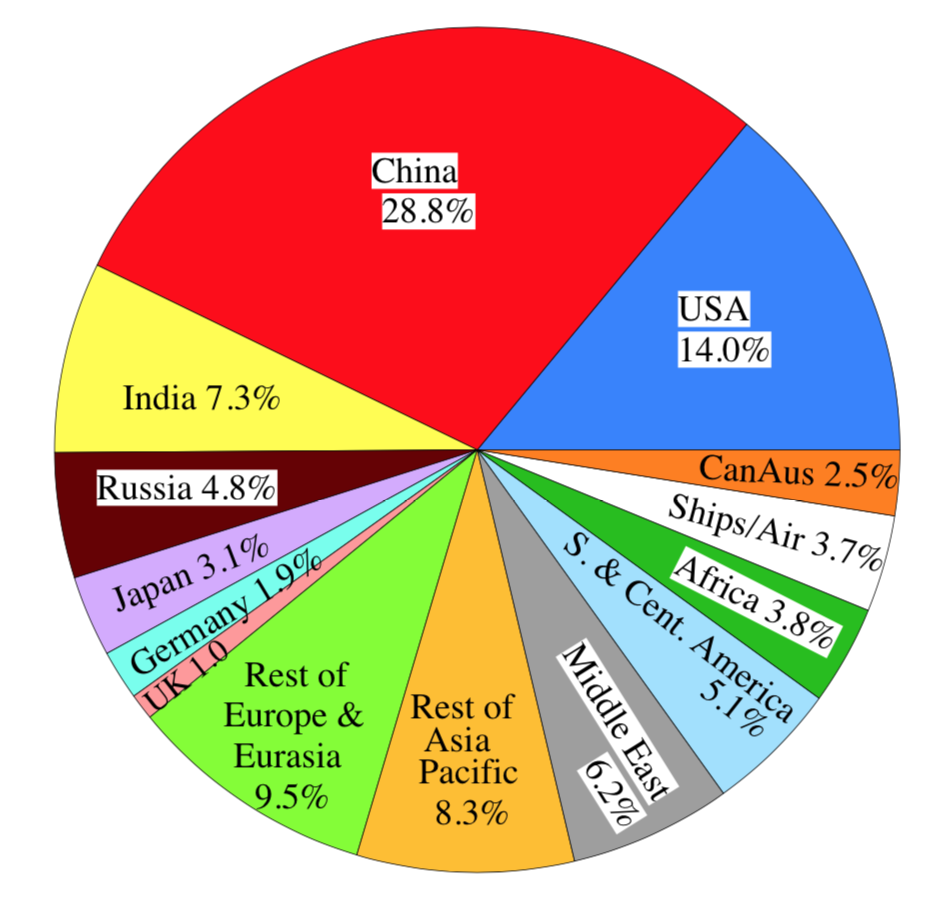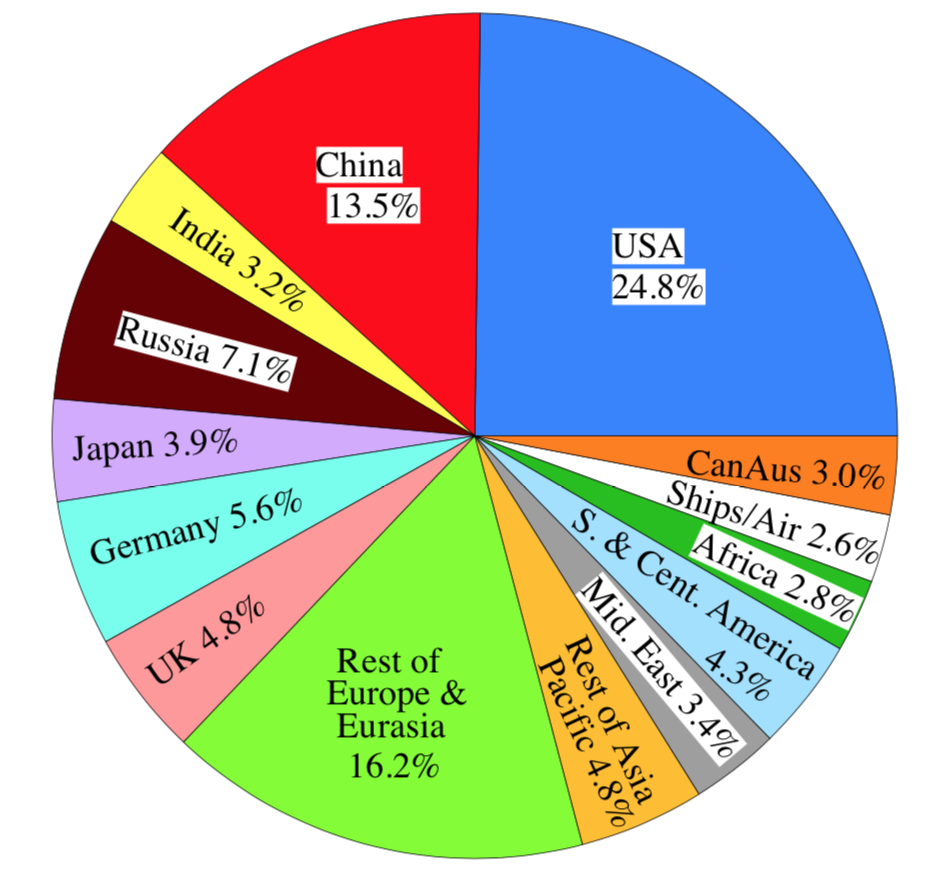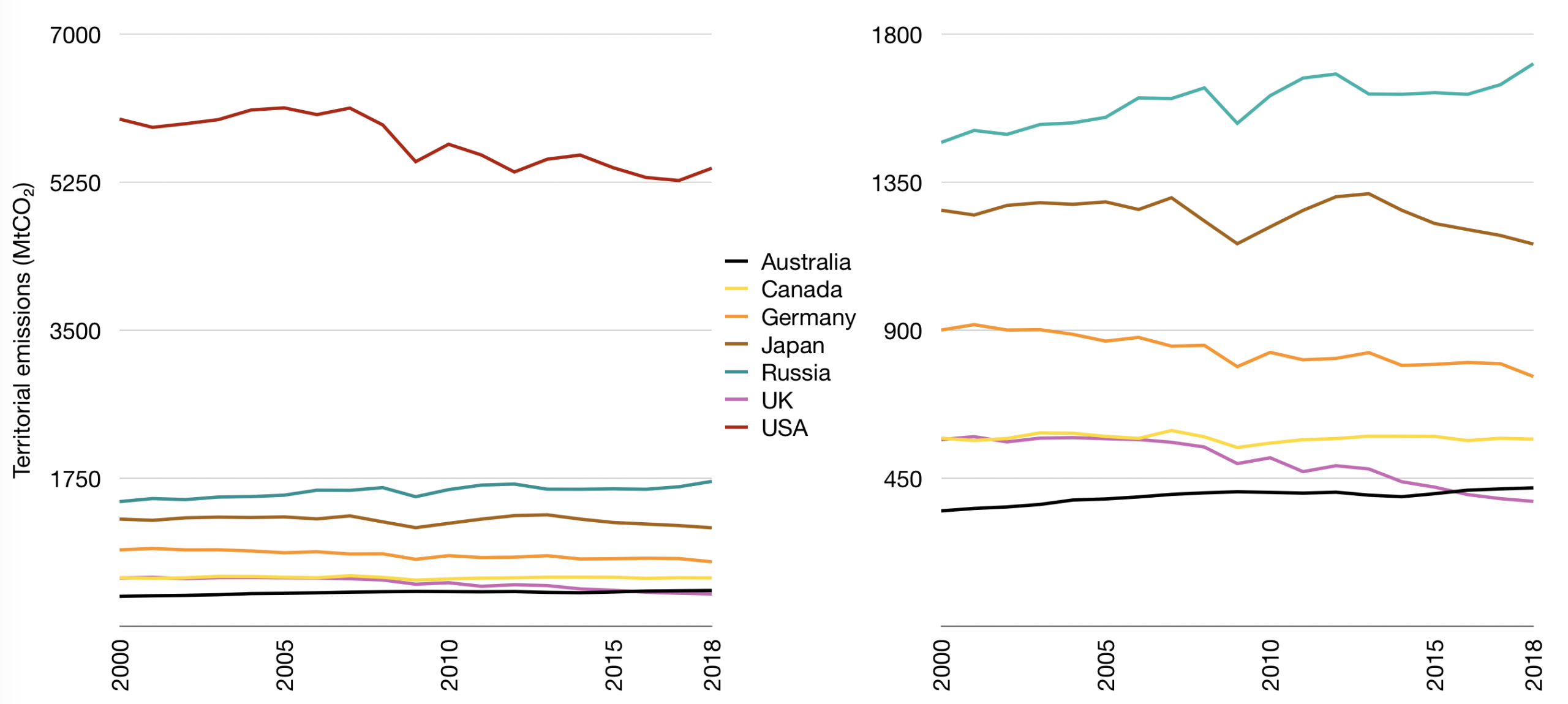Humanity’s fossil fuel CO2 emissions by country in 2018 are shown in chart 1.

But chart 2 shows China and India have contributed a much smaller share of total CO2 emitted since preindustrial times.

Furthermore, chart 3(a) shows that China’s per capita carbon emissions in 2016 were near global mean (or “average”), and India’s less. Chart 3(b) displays cumulative carbon emissions per capita from 1751 to 2018. This the the total quantity of carbon emissions emitted by each country since preindustrial times divided by the population of each country in 2018. China’s contribution is less than global mean and India’s contribution is tiny.

Those countries most to blame for climate change, and therefore should be leading wth radical mitigation, are those that have the highest cumulative-per-capita emissions: the U.S., U.K., Germany, Canada, Russia, Australia and Japan. Instead, these countries have been laggards as shown in Chart 4. (Although the UK’s emissions have declined, in 2017 the amount of CO2 emitted per unit of energy consumed has declined only to world average. The UK’s CO2 emissions were disproportionate due to a carbon-intensive energy system and industry)2

The most immediate priority of all nations is to make our climate safe and only science can prescribe the necessary changes. Arbitrary actions, that may be well intentioned, will be inadequate because there is no time remaining for half-measures.4
Winning slowly is the same as losing.
Bill McKibben, RollingStone.5
Arbitrary actions include carbon-offset schemes that may instead worsen matters because:
- some are marketing lies, unable to withstand scrutiny;6
- if credible, such carbon sinks should be implemented as rapidly as possible to help mitigate existing climate impacts, not instead used to clear the conscience of those indulging in carbon-intensive activities;
- economies cannot be completely decarbonised, so countries will need to increase their natural carbon sinks to compensate, leaving no surplus to be used for offsetting;
- 1.5˚C emission-pathways depend on massive and currently unfeasible CO2 removal. The IPCC state ‘CDR deployed at scale is unproven, and reliance on such technology is a major risk in the ability to limit warming to 1.5°C’,7 In light of this, carbon sinks should be made available for CDR instead of offsets;
- natural carbon sinks are subjected to disturbances that may permanently compromise their ability to sink carbon, or convert them to a carbon source (e.g. severe and or very frequent forest fire); and
- carbon payback times for forests may be very long, making the intended carbon offset useless for limiting warming. Estimates vary from less than 20 years to centuries.8
Two prominent endeavours have pursued the stabilisation of greenhouse gases to limit warming: (i) 1.5˚C pathways by the IPCC and UNFCCC; and (ii) ‘350 ppm’, the work of Dr James Hansen and colleagues. These are explained in the following posts, and the most important finding of both is that decarbonisation alone will now be inadequate, and ‘negative emission technologies’ (NETs), otherwise known as ‘carbon dioxide removal’ (CDR) methods, are required. These negative emissions are a burden imposed on young people.9
- Hansen, J. and Sato, M., 2016. Regional climate change and national responsibilities. Environmental Research Letters, 11(3), p.034009, https://doi.org/10.1088/1748-9326/11/3/034009 showing updated version from http://www.columbia.edu/~mhs119/RegionalDice/[↩][↩][↩]
- https://www.worldenergydata.org/the-energy-system-of-the-united-kingdom/[↩]
- http://www.globalcarbonatlas.org/en/CO2-emissions[↩]
- table 1, https://www.worldenergydata.org/summary/[↩]
- https://www.rollingstone.com/politics/politics-news/bill-mckibben-winning-slowly-is-the-same-as-losing-198205/[↩]
- https://www.mirror.co.uk/news/uk-news/licence-pollute-sham-carbon-offsetting-20873564.amp[↩]
- p. 96, IPCC Special Report on 1.5°C, J. Rogelj, D. Shindell, K. Jiang, S. Fifita, P. Forster, V. Ginzburg, C. Handa, H. Kheshgi, S. Kobayashi, E. Kriegler, L. Mundaca, R. Séférian, M. V. Vilariño, 2018, Mitigation pathways compatible with 1.5°C in the context of sustainable development. In: Global warming of 1.5°C. An IPCC Special Report on the impacts of global warming of 1.5°C above pre-industrial levels and related global greenhouse gas emission pathways, in the context of strengthening the global response to the threat of climate change, sustainable development, and efforts to eradicate poverty [V. Masson-Delmotte, P. Zhai, H. O. Pörtner, D. Roberts, J. Skea, P. R. Shukla, A. Pirani, W. Moufouma-Okia, C. Péan, R. Pidcock, S. Connors, J. B. R. Matthews, Y. Chen, X. Zhou, M. I. Gomis, E. Lonnoy, T. Maycock, M. Tignor, T. Waterfield (eds.)]. In Press. https://www.ipcc.ch/site/assets/uploads/sites/2/2018/11/SR15_Chapter2_Low_Res.pdf[↩]
- Woody Biomass for Power and Heat, Impacts on the Global Climate, https://reader.chathamhouse.org/woody-biomass-power-and-heat-impacts-global-climate#executive-summary[↩]
- https://www.earth-syst-dynam.net/8/577/2017/[↩]